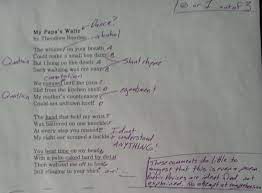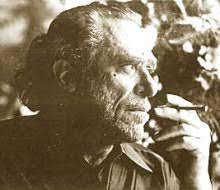
Teaching poetry can be tricky business. By middle and high school, many students have lost their taste for it. When teaching poetry, my hope is to bring the fun back—the same joy that made Shel Silverstein and Dr. Seuss a treat when students were younger.
I use a routine when students are just beginning to practice the unwinding of poetry’s mysteries. Students like structure–something concrete to hold onto–until they’ve built more confidence and become more adept at analysis on their own.
My routine goes like so:
1. I hand out a poem and a template (attached below this introduction).
2. I read the poem aloud not once but twice to emphasize the importance of multiple readings.
3. I ask students to silently read it a third time before they begin to individually mark the poem up using the bullet points on the template (note that looking up any unknown words–-whether done by the teacher to start or individually by students–is a must).
4. Once everyone has completed instructions in the template, I read the poem aloud AGAIN just before students form groups to share highlights of their mark-ups and the thesis statements they came up with (as if they were going to write a literary analysis of their own on the poem, although they are not–- that’s for later).
5. I instruct students to write a NEW thesis statement after discussion, one cobbled together by the group, one based on new realizations from their conversation, one that may be a composite of their individual ones or something completely novel.
6. Students write their group theses on the board OR share them with me on the computer (I use Google docs) so I can put them on the SMARTBOARD screen for all to see.
7. Each group challenges weaknesses in other group’s theses, and groups either defend or concede points. This is less intimidating than you think because it is the work of GROUPS and not individuals.
8. After the activity, a final thesis is agreed upon by all the students in the room and written on the board by the teacher, who may encourage further changes or not as he or she writes by saying, “But what about…?” and/or “Does this statement apply to ALL of the poem or only part of it?” And so forth.
9. At this point, in the practice phase slated for numerous weeks, an essay is not written. This activity is meant to encourage fun through repetition and a combination of individual and group work. You may do it once or twice a week, counting on it to fill up an entire class if done right (assuming 45-60 mins.).
10. The eventual goal? Students marking up poems on their own and writing their own thesis and essay for a grade. Teachers often move to this phase too soon. Using the template and many poems as practice leads to greater success.
Below, you will find
- a simple template for poetry analysis
- four poems I have used successfully in the classroom along with my own “Teacher’s Notes” and comments about instruction
- a list of 18 other poems I have used from Lost Sherpa of Happiness and The Indifferent World (I created this exercise before the release of my third collection, Reincarnation & Other Stimulants)
Please note that this template can be used with any poems in your classroom. If you have a textbook, however, do not be shackled by it. There’s too much great poetry around. Find good poems that you are passionate about. Write your own, even! (Trust me when I say the kids will love poems written by their teacher.)
Special note: If students have written their own poems, they, too, can be used for this process. When students mark-up and practice a thesis statement on each other’s poems, they give it special attention and can’t wait to read the work of classmates who have read and thought about their work.
In fact, it’s better yet if they know in advance that the poems they write will be used for this purpose. Think of it — THEIR writing important enough to be analyzed!
Name: ___________________________________________
Marking Up Poetry for Understanding
Poem: ___________________________________________ Author: __________________________________
Directions. Listen as your teacher reads the poem aloud twice. Then read the poem on your own, silently, marking it up by underlining key words or lines and adding annotations in the margins with the following prompts in mind:
- First highlight or circle any word you are not sure of, look it up with a dictionary (online or book), and write the meaning that best fits the context.
- Note connections you make to yourself, other works of literature, the world.
- Write questions near parts you do not understand. Then, after the question, write an educated guess as a possible answer to your own question.
- Circle examples of imagery (the five senses) and, in the margins, note possible moods these sensory details trigger.
- Note any other poetic elements you’ve discussed in class. How do they contribute to the poem’s mood and meaning?
- Zig-zag underline any cool words or lines, then note in the margins why you like them so much. How many of them are examples of figurative language or unusual word pairings?
- Does the poem take a “turn”? If so, draw a bold line where you see a sudden shift in direction and, in the margins, write, “Before the poet was talking about…, but now the poet is talking about….”
- Important lines are often found near the end of a poem. Draw an arrow to the line or lines you believe are most important, then write, “This is important because….”
- Look back at the title after completing your mark-up. Near it, write, “The title is important because it’s not just what the poem’s about, it also hints at….”
- In the white space below the poem, write a thesis statement. For multiple practices, use the following basic formula:
In “______ Title_______,” ______ Poet’s Name_____ (action verb in the present tense followed by one or more literary devices) to show that ____________(lesson about life that does its best to avoid clichéd statements) __________.”
Note: This formula has four key elements: the title in quotation marks (because poems are short works), the writer’s name, a topic, and an opinionated stand on that topic—one that someone could reasonably argue for or against.
After individual mark-ups, work with a group by sharing your thoughts first and co-writing a thesis statement together second. Beneath the thesis, make a list of textual evidence you would use to prove your argument against doubters in the classroom.
This form can be used for multiple practices, but eventually will become the basis of an analysis of a poem you choose or your teacher assigns. Good luck and have fun!
My Brother’s Thirteenth Halloween
by Ken Craft
That was the year our neighbor, Cherie, came over
and popped red wax lips into her mouth. Chastely
she kissed you with them, bro, not knowing that time
would leave its lipstick on your cheek. This was when death
was a plaything, an end-of-October thing. The R.I.P.
headstones Mom bought for the front lawn. The dancing
skeletons, joints jumpy with a string that lent us control.
The black-caped possibilities of being pretend dead.
Pale cuspids. Pulsing necks. Silver thrills from passing
mirrors and only seeing couch and lamps look back.
Remember? You and me alive as a team, bro?
Still young under the masks, still invincible, still in a place
where nothing could touch us, not even the approaching
Day of the Dead, not even the nights I’d travel to get there?
“My Brother’s Thirteenth Halloween” by Ken Craft, for educational purposes only, from Reincarnation & Other Stimulants, Kelsay Books, copyright 2021.
How the Dead Speak
by Ken Craft
I wondered, but my brother claimed no,
it’s never the dead speaking all at once
when aspen leaves scratch shivery
dialects against midnight’s window.
Same for ocean surf, he said,
when waves of foam and foment
break out in sizzle and doubt.
The dead don’t speak individually, either,
he insisted, so forget that fat June bug ping
on summer’s screen and any wisdom gleaned.
Hard-wrought words like that
are dismissed by the living, he assured me.
Mere bluebottle buzz, they’ll say,
or bumblebee drunk on blooming day.
More likely than any of this? As my brother
not only predicted but eventually proved himself,
the dead speak not at all. Winds fall.
Seas flatten. The night peers back.
“How the Dead Speak” by Ken Craft, for educational purposes only, from Reincarnation & Other Stimulants, Kelsay Books, copyright 2021.
Dog Religion
by Ken Craft
Each morning he rises and bows
before me—parable of humility,
maw yawning, paws splaying.
The hollow rattle of dry meal
raining on his aluminum bowl
pops his ears. Every day,
novelty in the ritual of repetition;
every day, the Pavlovian ear perk.
Like heartbeats and bad breath,
autonomous tail and tongue.
Just so.
Waiting for me
to move, he approaches the orb
demurely, noses in, crunches the bland
and the brown. That lovable greed.
Those stained, pacifist teeth.
He feeds, license and rabies tag
keeping time at bowl’s edge. And always,
in the end, one dry kibble
is left in a bowl cirrus-streaked
with spit: his offering
to the food gods, his prayer
answered each miraculous day.
“Dog Religion” by Ken Craft, for educational purposes only, from The Indifferent World, Future Cycle Press, copyright 2016.
Passenger Seat, Route 1A
By Ken Craft
My God, the boxes:
trailers and double-wides,
the ranches and the shacks,
the sheet-clotted windows, open
doors gagging up
one-armed dolls
and stained
blankets pregnant with rain
and mildew. Post-apocalyptic
lawn mowers
abandoned mid-swath
lean against berms of tall grass
thick with the thrum of crickets
and August.
But the boxes most of all!
The pennants at the ends
of their dirt driveways
proclaiming cottage industries:
OPEN flags, once-colorful,
Once-waving, now limp and anemic
with sun and years.
The hand-painted signs
spelling Wild Maine Blueberries
or Tourmaline Here or Camp Firewood $5
in crooked letters.
And I think, with my brow
against air-conditioned glass,
my God, can they get out?
Can they escape? Are they happy?
It’s only when we hit
the pothole and I bump
my forehead that I remember
the moving box I am in.
My God.
“Passenger Seat, Route 1A” by Ken Craft, for educational purposes only, from Lost Sherpa of Happiness, Kelsay Books, copyright 2018.
Escape Plan
By Ken Craft
“This is us,” he’d say, pointing at the boxed red “x”
above our room number, “but if there’s a fire, you sure
as hell won’t have any red arrows along the hallway
carpet. You’ll have that bath towel you just
wrung water out of over your little head. You’ll be
on your hands and knees like you just found God.
And you’ll have darkness and smoke with screamers
tripping over your body. But you’ll be following the way.
The way you’re going to memorize right now: left twice
around two corners to the stairwell door. And, if that’s
not hotter than a cannon, you’ll push it open.
Only then will you stand like a goddamned ghost
under your towel, hold the stair railing if you can, and run
down those stairs like each step’s a wrapped gift
of years, because each one brings you closer to this exit”
(his stubby finger finds the bold, diagrammed frame
of a ground-level door), “to the fire trucks and flashing lights,
to the big sound of engines and sirens. Outside’ll be the smell
of soot and the glow of fear on all those fire-lit faces
watching this place go up. But that’s not important.
You’ll be gulping the biggest mouthfuls of smoke-ringed stars
and night-fresh air you’ve ever swallowed, and you’ll be grateful.
Damn grateful, because it’s not always the fire, it’s the CO2!
Understand? You visualizing good, like I told you?”
And then, like every first hour in every hotel, I took a white
towel, dry for the drill, and draped it over head and back. Like
a fallen angel, wings clipped by dread’s shears, I crawled
down the hallway’s edge, feeling the clench of my eyes
squint their smoldering embarrassment as other guests
walked by, feeling the hot whites of my father’s eyes
watching from behind.
“Escape Plan” by Ken Craft, for educational purposes only, from Lost Sherpa of Happiness, Kelsay Books, copyright 2018.
Simplicity
By Ken Craft
When you’re broken,
find your Henry David
and simplify. Reach
back, grasp your younger
hand, squeeze and hold
until your palms’
warmth mingles.
Together, walk the woods,
smell distant rain
as it rides westerlies
bareback and brazen.
Forget time. Keep going
through yellow birch and red
maple till you discover
an unmapped pond, sit on
a shoreline boulder,
feel the chill itch
permeate to your skin.
Follow the exhaling water
rings when a smallmouth
kisses the surface simply
because it exists, waiting
to be marred with life.
Even fish sense there is
another side, near yet far,
alluring yet fatal,
with many years to gasp and gulp
at the gilled wonder
of it all.
“Simplicity” by Ken Craft, for educational purposes only, from The Indifferent World, Future Cycle Press, copyright 2016.
Teacher/Author’s Notes
These poems are suitable for upper middle school and high school students. The presence of a few “mature” words in some simply seals the deal on poems being realistic and true to life. I read as if these words are insignificant, and if they are to me, they are to the students. It’s understood between us. We both are fully aware of the world out there. It is what it is, and we collectively know that.
1. “My Brother’s Thirteenth Halloween”
The “turn” in this poem comes at the end with these lines:
Remember? You and me alive as a team, bro?
Still young under the masks, still invincible, still in a place
where nothing could touch us, not even the approaching
Day of the Dead, not even the nights I’d travel to get there?
As big fans of Halloween, students will enjoy all the familiar props associated with that date: headstones, skeletons, vampires (who, fans of the genre know, cannot see their own image in a mirror). “Playing” at death and matters scary is part of October 31st’s fun, but the poem turns serious at the end when the narrator reveals the loss of his brother long ago. At this point, the poem turns to a meditation on youth and those glorious days when we were “invincible,” when “nothing could touch us.” Finally, there is a reference to the Day of the Dead, the day after Halloween (Nov. 1st). It’s a perfect segue to for the poem’s topic, with the last line (“the nights I’d travel to get there” referring to the speaker’s realization that death is not all fun and games. This realization comes suddenly to those who experience the death of a loved one and eventually to those who grow up and lose their innocent naivete about such matters.
2. “How the Dead Speak”
The “turn” in this poem comes in the final stanza:
More likely than any of this? As my brother
not only predicted but eventually proved himself,
the dead speak not at all. Winds fall.
Seas flatten. The night peers back.
The first three stanzas take readers back to a time when two brothers discussed whether the dead could reach out and speak to the living – not through the medium of a séance or a Ouija board, but through the sounds of nature that could be interpreted as “language” by believers. In the turn, the brother who doubts such superstitions proves himself correct in an unfortunate way. Though the reason for his demise is never revealed, this skeptical boy’s words are remembered through a glass darkly — readers understand that the brother left behind longs to communicate with his lost brother but is unable to. Nature is nature. It speaks for itself and itself alone: “Winds fall. / Seas flatten. / The night peers back.” Each of the short lines implies silence of the eternal sort.
3. “Dog Religion”
The “turn” in this poem comes at the end with these lines:
…And always,
in the end, one dry kibble
is left in a bowl cirrus-streaked
with spit: his offering
to the food gods, his prayer
answered each miraculous day.
The poem celebrates the sheer joy for life embodied by dogs. Although the “food gods” is a joke (and a true story about my own dog!), it’s really meant to show how lucky we are and how grateful we should be for what we have. We provide for our pets, but there are many in this world who provide for us, too. Do we take them for granted?
The poem also features use of the dash for importance, of what follows, good vocabulary words: an allusion to a Russian physiologist (Ivan Pavlov with his famous “conditioned response” experiment with bells and dogs), effective repetition, figurative language, and hyphenated adjectives.
After reading this and marking it up for thesis purposes, I have students write about a pet they own or wish they owned, using many of the same poetic elements seen here. Animals, wild and domestic, are a good inspiration for writing.
4. “Passenger Seat, Route 1A”
The “turn” in this poem comes at the end with these lines:
It’s only when we hit
the pothole and I bump
my forehead that I remember
the moving box I am in.
My God.
Students pick up on the disparity between the poem’s narrator – a passenger in a car passing impoverished areas of Maine – and the scenes viewed outside the window. What they are less likely to see is the significance of the word “box,” which links car to trailers and hints at the similarities between rich and poor and middle class and in between. The “box” is symbolic of the ultimate box we will all share, a coffin. Death does not care about class or wealth, in other words. That said, I count it a success when students find the thesis in class differences and how the narrator has an “epiphany” of sorts, understanding his similarities with all humanity. NOTE: If a poem about death is too much of a downer for you or your students, take a pass on this one.
5. “Escape Plan”
The “turn” in this poem comes at the end with these lines:
And then, like every first hour in every hotel, I took a white
towel, dry for the drill, and draped it over head and back. Like
a fallen angel, wings clipped by dread’s shears, I crawled
down the hallway’s edge, feeling the clench of my eyes
squint their smoldering embarrassment as other guests
walked by, feeling the hot whites of my father’s eyes
watching from behind.
Students are drawn to the literal in this poem, often lauding the father for coaching his son for safety purposes. If they don’t on their own, encourage them to consider the boy’s point of view, however. Compliment the students who circle the word “embarrassment,” as this is more about an authority figure who oversteps bounds and abuses his “powers” to a point where it is beyond the pale. It can be paired with many other poems where power (by teacher, coach, commander, older sibling, parent, etc.) is abused.
6. “Simplicity”
The “turn” in this poem comes at the end with these lines:
Even fish sense there is
another side, near yet far,
alluring yet fatal,
with many years to gasp and gulp
at the gilled wonder
of it all.
Count it a win if students focus on “another side, near yet far / alluring yet fatal” and see that this is simply a poem celebrating life and acknowledging that death is a part of it and nothing to be feared. Celebrate the “many years to gasp and gulp / at the gilled wonder / of it all,” then. This poem is influenced by the Buddhist philosophy, which encourages both awareness of our mortality and emphasis on the here and now, the present moment. This poem, then, is a celebration of present moments, and a call for all humans to keep in touch with their inner youth.
FINAL NOTE TO FELLOW TEACHERS: If you like lesson plan ideas and want to show it by helping me with the costs of running this site (no, it’s not free), click over to the BOOKS page and purchase one of my poetry collections. Every little bit helps — honest! Thanks.









